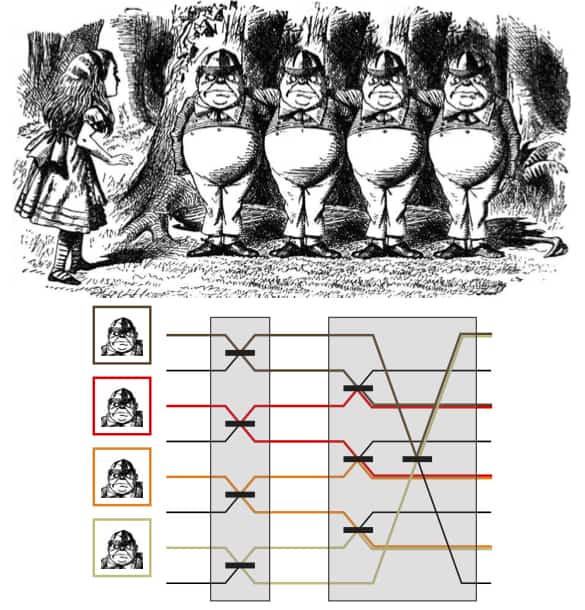How indistinguishable are indistinguishable photons? New optical interferometer puts a number on it


In a sample of indistinguishable photons, just how indistinguishable are they? An international team of scientists has now answered this question by making the first precise measurement of multi-photon indistinguishability. Using an innovative type of optical interferometer based on interconnected waveguides, the team showed that it is possible to check both the performance of single-photon sources and the generation of multi-photon states in quantum optics experiments – an achievement team member Andrea Crespi describes as adding “an extra element to the toolbox of the quantum optics experimenter”.
In the everyday world governed by classical physics, we can always find ways to tell which macroscopic object is which, even if many objects look superficially identical. In the quantum world, however, particles can be identical in a profound sense, explains Crespi, a physicist at the Polytechnic University of Milan, Italy. This makes it truly impossible to distinguish one particle from the other and leads to wave-like behaviours such as interference.
These unusual behaviours make identical photons a key resource in optical quantum technologies. In quantum computing, for example, they form the basis of the qubits, or quantum bits, used to perform calculations. In quantum communication, they are used to send information over large-scale quantum networks.
Proving genuine indistinguishability
To check whether two photons are indistinguishable, researchers usually send them through an interferometer in which two channels, or waveguides, are so close that each of the photons can pass through either of them. If the two photons are perfectly indistinguishable, they always end up together in the same waveguide. However, this technique cannot be used for larger sets of photons, because even if it was repeated for all possible two-photon combinations, it would still not be enough to fully characterize the multi-photon set. This is why “genuine indistinguishability” – a parameter that quantifies how close a set of photons is to this ideal, identical state – is so difficult to measure for multiple photons.
In the new work, researchers from Milan and the University of Rome “La Sapienza” in Italy; the Italian Research Council; the Centre for Nanosciences and Nanotechnology in Palaiseau, France; and the photonic quantum computing firm Quandela constructed an “indistinguishability test” for four photons. Their system consisted of a glass slab in which they had imprinted eight waveguides using a laser-writing technique. Using a semiconductor quantum dot source, they repeatedly sent the photons into the waveguides, then recorded which ones were occupied with a photon.
Next, they used a microheater to warm up one of the waveguides that contained a photon. The increase in temperature altered the waveguide’s refractive index, inducing a change in the photon’s optical phase and causing it to hop to another one of seven waveguides thanks to interference effects.
The experiment showed that the amplitude of the oscillations between waveguides could be used to determine the genuine indistinguishability parameter, which is a number between 0 and 1 (with 1 corresponding to perfectly identical photons). In their experiment, they calculated an indistinguishability of 0.8.
“In the case of n photons, the concept of genuine indistinguishability quantifies in the most authentic way how impossible it is to distinguish these particles and it is related to how pronounced the collective quantum interference effects are,” Crespi explains. “Our technique to measure this quantity is based on a new kind of interferometer designed to give, at its output, unusual interference effects that ‘distil’ the collective genuine indistinguishability of the full set of n photons with respect to the indistinguishability of partial subsets.”
Tools for quantum optics
While the technique could work with more than four photons, the number of measurements required to observe variations for indistinguishability increases exponentially with the number of photons. It would therefore not be practical for 100 photons or more, which is the likely number required for a future optical computer. That said, Crespi says it could be used in quantum optics experiments in which scientists need to know whether photons are indistinguishable or not.

Interference wall captures single photons
“The genuine indistinguishability is a crucial parameter that provides information on the quality of a multi-photon source and determines how these n photons could be used complex information states,” he tells Physics World. “To develop reliable technologies that demonstrate quantitative advantages for quantum information process and transfer, it is critical not only to develop good sources but also to develop methods to characterize and quantify the quality of these resources.”
Team member Sarah Thomas, who is now a postdoc in quantum optics at Imperial College London, UK, says the method could be used to quantify how good resource states are for experiments such as Boson sampling. “Such a characterization tool will be useful in understanding the current limitations in building multi-photon states and the implication this has on quantum interference, and therefore potentially finding routes towards improving these resource states,” she says.
According to the researchers, their innovative device allows them to directly observe peculiar interference effects that may open new paths to fundamental research on multi-particle quantum interference, even beyond photonics. “We could explore the implications of these effects in quantum metrology – that is, for the enhanced estimation of physical quantities by means of quantum-enabled effects,” Thomas reveals.
The present work is detailed in Physical Review X.



